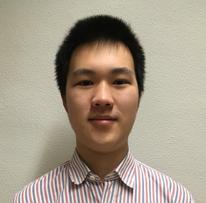
Dayou Zhang is the recipient of the 2021-2022 Robert and Jill DeMaster Excellence Fellowship. This is a very competitive fellowship and is a strong endorsement of his accomplishments so far in our graduate program.
Dayou’s work has already led to four publications:
1. “Spin Splitting Energy of Transition Metals: A New, More Affordable Wave Function Benchmark Method and Its Use to Test Density Functional Theory,” D. Zhang and D. G. Truhlar, Journal of Chemical Theory and Computation 16, 4416-4428 (2020). doi.org/10.1021/acs.jctc.0c00518
2. “Unmasking Static Correlation Error in Hybrid Kohn–Sham Density Functional Theory,” D. Zhang and D. G. Truhlar, Journal of Chemical Theory and Computation 16, 5432-5440 (2020). doi.org/10.1021/acs.jctc.0c00585
3. “Multiconfigurational Effects on the Density Coherence,” D. Zhang and D. G. Truhlar, Journal of Chemical Theory and Computation 16, 6915-6925 (2020). doi.org/10.1021/acs.jctc.0c00903
4. “Multiconfiguration Density-Coherence Functional Theory,” D. Zhang, M. R. Hermes, L. Gagliardi, and D. G. Truhlar, Journal of Chemical Theory and Computation 17, 2775-2782 (2021). doi.org/10.1021/acs.jctc.0c01346
Paper 1 presents a new algorithm, CASPT2.5, for accurate calculations on strongly correlated systems. It also tests this algorithm and several other multireference methods on transition metal spin-splitting energies for which the standard CCSD(T) method fails. The CASPT2.5 method is found to be very accurate with an affordable cost for small molecules and it is used to provide benchmark spin-splitting energies and geometries for transition metal complexes. These were used to test 60 exchange-correlation functionals. The MN15-L method was validated to perform very well for spin splitting. We believe that CASPT2.5 and MN15-L can be very useful for calculating spin splittings, which are important for many technical applications.
Accurately treating strongly correlated systems is a challenging task for Kohn–Sham density functional theory (KS theory). The factors underlying its inaccuracy are only partly clear, especially regarding static correlation. To unmask the static correlation error, paper 2 compares the potential energy curves of four diatomic molecules, namely H2, F2, HF, and NaF, using restricted and unrestricted KS theory. With the aid of restricted KS theory calculations, Dayou found that limiting the percentage of Hartree–Fock exchange significantly reduces the static correlation error in Hartree–Fock theory. This work extends and builds upon a stimulating paper of Nobel Laureate Martin Karplus. Dayou showed that utilizing restricted KS calculations is a useful tool to elucidate the origin of static correlation error in KS theory. One reviewer commented, “It is useful that it is brought home to the readers that there may be important drawbacks to the inclusion of exact exchange, and what the problems are exactly.” Another reviewer said, “I think this is a very interesting perspective on static correlation and I think the authors do a good job of supporting their claims with calculations.”
Paper 3 is a study of density coherences in multiconfiguration self-consistent field theory and Kohn−Sham density functional theory. The density coherences under study here are the off-diagonal elements of the one-body density matrix. Although the one-body density matrix is a central quantity in wave function and density functional methods, it has not been nearly as widely studied as the density itself, which is the diagonal part of the density matrix in the coordinate representation. Dayou compared CASSCF, Hartree–Fock, local Kohn–Sham theory, and hybrid Kohn–Sham theory for the density coherence. The quantitative conclusions are quite striking, showing larger deviations among the methods than one might have expected. We expect that there will be much more emphasis on the density matrix in the near future, and this study can lay a groundwork for general expectations and thereby help guide the development work.
Paper 4 describes a new theory — multiconfiguration density coherence functional theory — and it demonstrates its promise for representing the correct physics of static and dynamic correlation. Potentially it allows new strategies for designing density matrix functionals that take advantage of the physical interpretation of the number of unpaired electrons rather than unphysical effective spin densities. Dayou’s paper shows that already with just two parameters he can get good results for bond energies, equilibrium distances, vibrational frequencies, and potential curves.
In addition to his published work, Dayou has completed a fifth project and has a sixth in progress. Project 5 analyzes static and dynamic electron correlation by decomposing the total electronic energy of calculations by restricted Hartree–Fock (RHF) theory, complete active space self-consistent field (CASSCF) theory, and multireference configuration interaction (MRCI). Dayou is using two different schemes to break down the total energy contributions to the potential energy curves for the dissociation of diatomic molecules. He finds that a significant portion of the static correlation comes from the part of the energy that is not expressible in terms of the one-body reduced density matrix. He also finds that negligible static correlation is included in the sum of the effective one-electron energy and the classical two-electron energy, which provides a way to understand the success of multiconfiguration pair-density functional theory (MC-PDFT) and multiconfiguration density coherence functional theory (MC-DCFT). This kind of analysis of energetic contributions to the total energy in terms of different components of the two-body reduced density matrix has never been done before, and it leads to fundamental understanding.
In project 6, Dayou is developing new strategies for multi-parameter optimization of density coherence functionals.